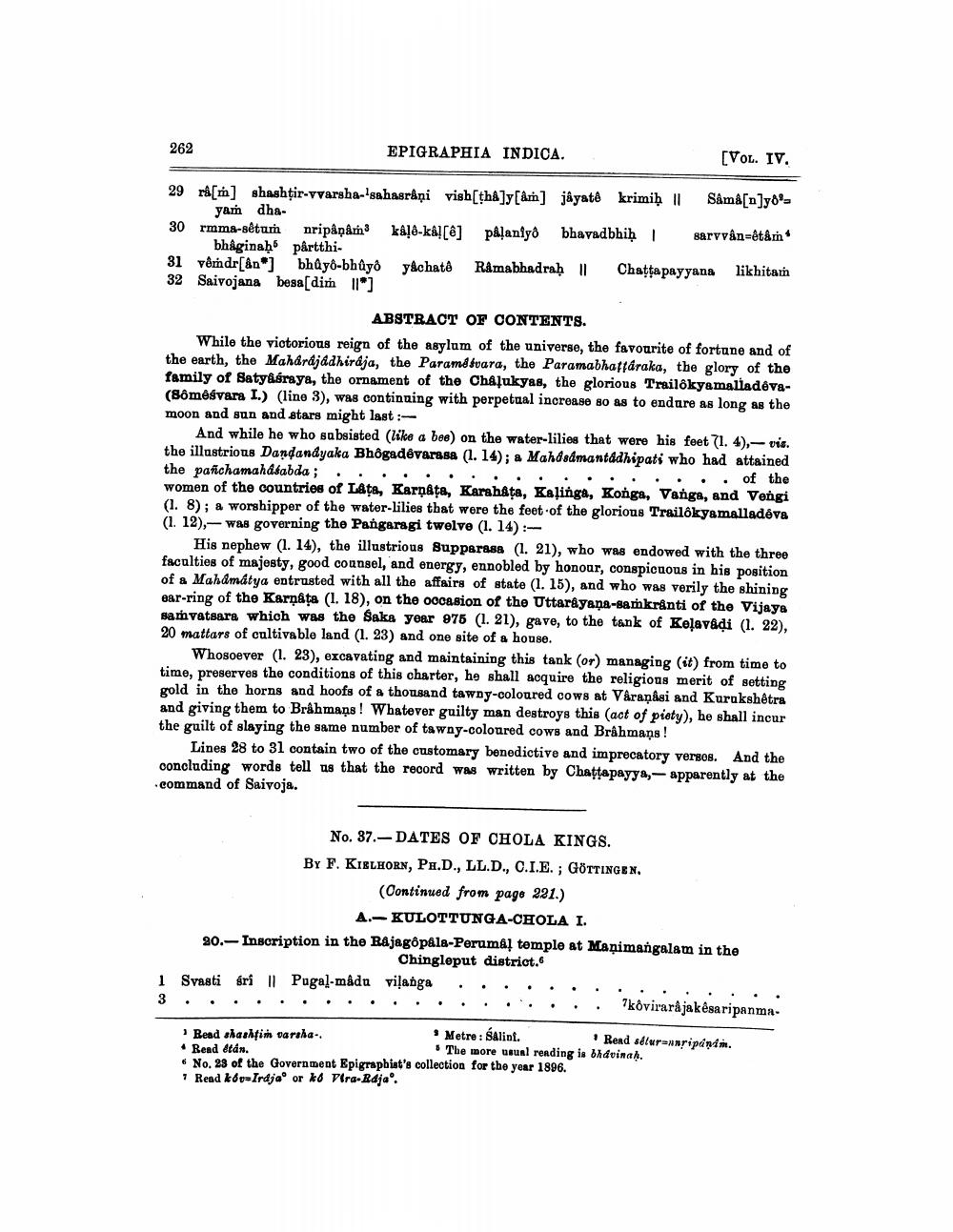________________
262
EPIGRAPHIA INDICA.
(VOL. IV.
29 rå[] shashțir-vvarsha-sahasråņi vish[th]y[Am] jậyatê krimiḥ || Sama[n]yol
yam dha30 rmma-sêtum nripåņ& k&ļ8-ka![@] påļaniyo bhavadbhiḥ sarvvân=et&m
bhåginaḥ pârtthi31 vêm dr[ano] bhấyÔ-bhûyê yêchatë Ramabhadraḥ || Chatta payyana likhitan 32 Saivojana besa[dim 11*]
ABSTRACT OF CONTENTS. While the victorious reign of the asylum of the universe, the favourite of fortune and of the earth, the Maharajadhiraja, the Paramëtuara, the Paramabhaffaraka, the glory of the family of Satyasraya, the ornament of the Chalukyas, the glorious Trailokyamalladeva(8ômégvara I.) (line 3), was continuing with perpetual increase so as to endure as long as the moon and sun and stars might last :
And while he who subsisted (like a bee) on the water-lilies that were his feet (1.4), vis. the illustrious Dandandyaka Bhogadêvaraga (1. 14); a Mahdsdmantadhipati who had attained the pañchamahdlabda ; . . . . . . . . . . . . . . . . . of the women of the countries of L&ţa, Karnata, Karahata, Kalinga, Konga, Vanga, and Vengi (1. 8); a worshipper of the water-lilies that were the feet of the glorious Trailôkyamalladeva (1. 12), was governing the Pangaragi twelve (1. 14) :
His nephew (1. 14), the illustrious Supperasa (1. 21), who was endowed with the three faculties of majesty, good counsel, and energy, ennobled by honoar, conspicuous in his position of a Mahámátya entrusted with all the affairs of state (1. 15), and who was verily the shining ear-ring of the Karnata (1. 18), on the ocasion of the Uttarayana-samkrinti of the Vijaya samvatsara which was the Sake year 975 (1. 21), gave, to the tank of Kelavadi (1. 22), 20 mattars of cultivable land (1. 23) and one site of a house.
Whosoever (1. 23), excavating and maintaining this tank (or) managing (it) from time to time, preserves the conditions of this charter, he shall acquire the religious merit of setting gold in the horns and hoofs of a thousand tawny-coloured cows at Varanasi and Kurukshetra and giving them to Brâhmans! Whatever guilty man destroys this (act of piety), he shall incur the guilt of slaying the same number of tawny-coloured cows and Bråhmans !
Lines 28 to 31 contain two of the customary benedictive and imprecatory verses. And the concluding words tell us that the record was written by Chattapayya, - apparently at the command of Saivoja.
No. 37.-DATES OF CHOLA KINGS. BY F. KI8LHORN, PH.D., LL.D., C.I.E.; GÖTTINGEN,
(Continued from page 221.)
A.-KULOTTUNGA-CHOLA I. 20.-Inscription in the Rajagopåla-Perumal temple at Manimangalam in the
Chingloput district. Svasti eri | Pagal-mâdu viļanga .
. . . . . . . . . . . . . . . . . . . . . 7kóvira råjakesaripanma
1 3
Bead shashti Darsha..
• Metre : salin.
Rend séturangipani. • Bend étán.
* The more usual rending is bldvinah. • No. 23 of the Government Epigrapbiat's collection for the year 1896. * Read kor-Indjao or k8 Pira-Raja'.




